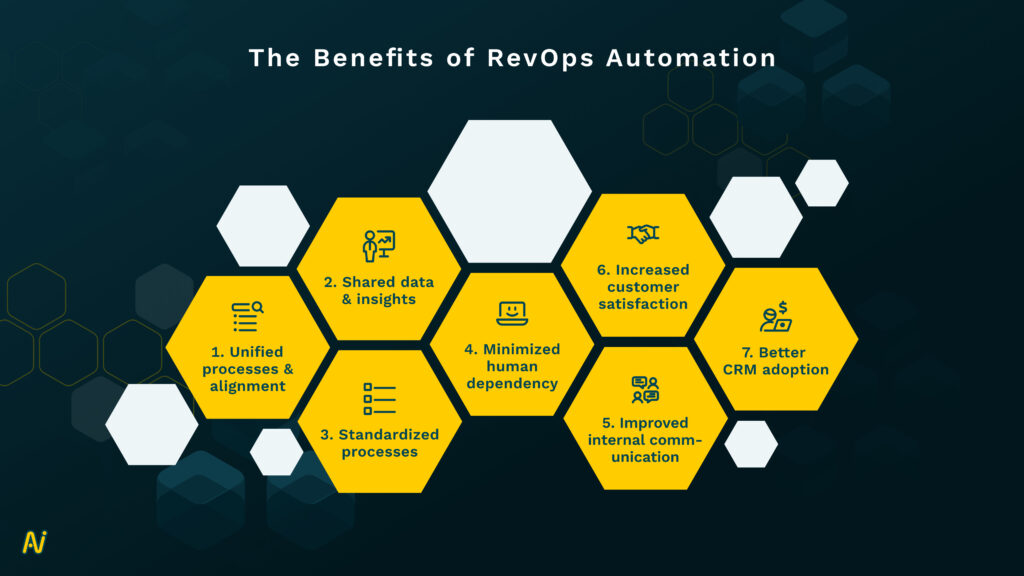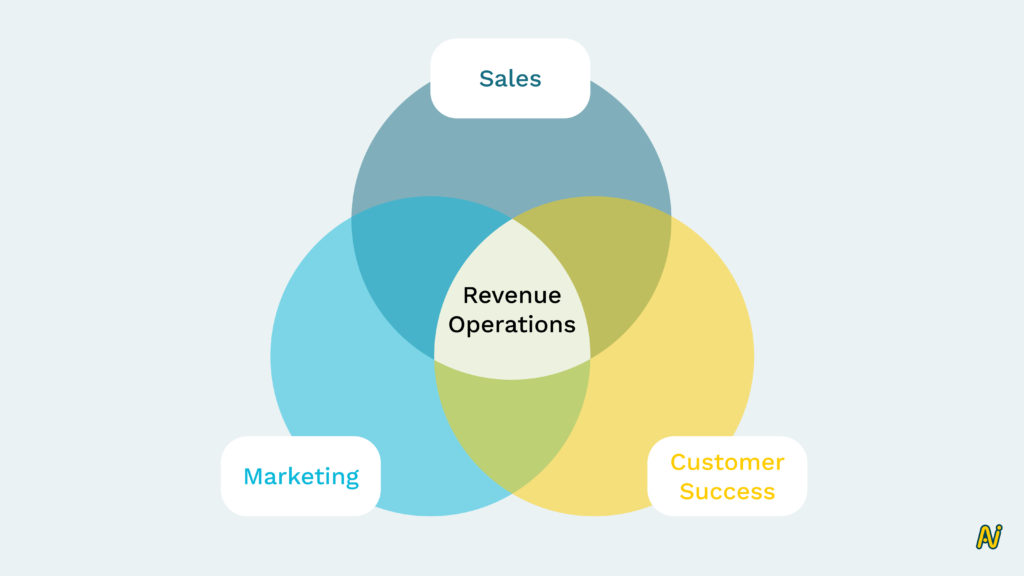
3 RevOps Automation Areas to Boost Your Revenue
What is RevOps automation and how can its application elevate your revenue engine? Get details in this blog.
RevOps is always a struggle between tactical and strategic. On the one hand, it needs to ensure the alignment of different revenue functions. On the other hand, it is very easy to get burdened by daily operational tasks.
In order to provide RevOps a seat at the strategy table, organizations need to free RevOps from being pulled into multiple corners. This is where RevOps automation comes in. By automating repetitive tasks, such as data entry and lead nurturing, sales, marketing, and customer success, teams can focus on higher-level tasks that require a human touch, such as building relationships with customers and developing strategic growth plans.
Learn how RevOps can create team alignment in our blog here.
Let’s have a detailed look at the benefits of automating RevOps:
The Benefits of RevOps Automation
RevOps automation can unleash several benefits to make the function of revenue operations friction-free across the four pillars of people, process, technology and data. Let’e look at some of these key benefits:
1.Unified processes & alignment
Using Marketing Automation, Project Management, and CRM software tools, you’ll drive collaboration across all departments and ensure that everyone is working towards a common goal.
2. Shared data and insights
By automating the collection and analysis of data, all teams can access the same data, which helps break down silos between departments and create a more collaborative environment.
3. Standardized processes
Automation can help standardize processes, making them more consistent and predictable. This is particularly important when working across departments, as it helps ensure that everyone is following the same procedures.
4. Minimized human dependency
Automation can play a significant role in minimizing human dependency in RevOps by streamlining processes, reducing errors, and increasing efficiency. Here are some ways automation can help reduce human dependency:
a. Automate repetitive tasks
Automation can help minimize human dependency by automating repetitive tasks, such as data entry, lead nurturing, and reporting. This frees up time for more strategic tasks.
b. Improve data accuracy
Automation can help minimize errors by automating data collection and analysis, which reduces the risk of human error. This leads to more accurate data and insights, which can help inform decision-making and drive revenue growth.
c. Increase efficiency
Automation can help minimize human dependency by making processes more efficient and reducing the need for manual intervention. This enables teams to work more effectively and achieve their revenue goals more quickly.
d. Facilitate scalability
Automation can help minimize human dependency by making processes more scalable, enabling teams to handle larger volumes of data and work more efficiently. This is particularly important when organizations are experiencing growth and need to expand their revenue generation activities.
e. Streamline workflows
Automation can help streamline workflows by automating repetitive tasks and eliminating manual processes, freeing up time for more strategic tasks.

5. Improved internal communication
Automation can improve communication and collaboration by providing real-time updates and alerts, which helps keep all teams informed and aligned. Introducing automation tools and setting up workflows for all teams will improve internal processes with easy reporting and assignment review.
6. Increased customer satisfaction
By unifying processes, teams can create a more cohesive and personalized experience for customers, which helps improve customer satisfaction and loyalty. Here are a few ways automation helps in customer satisfaction:
a. Faster response times
Automation can help reduce response times to customer inquiries by automating responses to common questions or issues. This ensures that customers receive a prompt response, even outside of business hours, which can help improve customer satisfaction.
b. Consistent and accurate information
Automation can help ensure that customers receive accurate information by providing a centralized platform for all customer interactions. This ensures that all teams have access to the same information and are following the same procedures, which can help prevent errors and misunderstandings.
c. Streamlined processes
Automation can help streamline processes, such as order processing and shipping, which can help ensure that customers receive their products or services in a timely and efficient manner. This can help improve the customer experience and increase satisfaction.
7. Better CRM adoption
Customer Relationship Management (CRM) systems are important tools for managing customer interactions and improving sales and marketing effectiveness. However, one of the biggest challenges faced by organizations is driving the adoption of CRM systems among their employees. Automation can play a key role in driving better adoption of CRM systems by making it easier and more convenient for employees to use the system.
Tools like Nektar work silently in the background and provide sales teams powerful insights about deals – without anyone having to lift a finger. It ensures that there is no dependence on the rep to manually upload CRM data.
Learn the benefits of improving CRM data quality here.
Now that we have discussed the various benefits of automating RevenueOps let’s have a look at the areas under RevenueOps that can be automated:
Different Areas to Automate in RevOps
A revenue operations function primarily supports and aligns three customer-facing functions in an organization – sales, marketing and customer success. Let’s see how RevOps automation can benefit these three core functions:
Sales
Automated data capturing and an intelligence layer on the top of your sales funnel can help your sales leaders in achieving repeatable sales success. Here are some ways automation can help the sales function:
a. More active contacts
All your contacts should be auto-discovered from all sales tools. They are then further bifurcated into buying group roles; and auto-mapped to active opportunities in Salesforce or other CRM tools.
b. Increased pipeline visibility
Real-time activity intelligence focuses on the right deals with in-depth intelligence for every deal, highlighting rep performance, pipeline progression, and the risks to mitigate.
c. Facilitates remote sales team
You can asynchronously guide your reps with 1:1 personalized coaching. You can also replicate the winning behaviors of your top performers and standardize your sales execution.
d. Prospect intelligence
Automation tools can grant your reps the knowledge of whom to engage, how, and when to best influence deal progress.
Marketing
Automating your marketing processes ensures that your online marketing campaigns are optimized for maximum engagements, lead generation, and conversions. Here are a few ways automation can make your marketing more efficient:
a. More first-party contacts
You get a bigger custom audience list for all your ABM campaigns. You can also revive historic opportunities and accelerate ongoing opportunities.
b. Boost funnel conversions
Your team gets maximum account coverage and can target key buying committee members with relevant messaging and content at the right time.
c. Better marketing-sales partnership
Get real-time visibility into how the sales team is managing every opportunity and support faster deal closures by engaging the right buyer at the right time.
Customer Success
Automating your customer service allows customers to raise tickets seamlessly through a CRM. You get to track their high and low points and have a clear view of where and why things went wrong and possible solutions.
Here is how automation can help your customer success team:
a. Increased LTV of customers
Get product usage data that allows you to take action on go-to-market initiatives, cross-sell opportunities, and drive adoption.
b. Automate customer support
Send real-time alerts and automatically escalate tickets to resolve the issues instantly.
c. Improve customer experience
Automatically resolve customer pain points. Manage renewals, provision users, poor adoption, and predict future issues – all without manual intervention.

RevOps Automation Areas to Consider
Automating various areas adds different values to RevOps. However, in order to automate these areas, some specific tasks need to be taken care of.
Here are some revenue operations tasks that can be automated to provide value:
1. Emails
Automating emails enables you to configure an email message just once, and whenever a specific circumstance is satisfied, the email is dispatched automatically. As a consequence, the more new contacts are generated, the less extra work you need to put in.
2. Meetings/E-meetings
Instances of forgotten meetings, conflicting schedules, and misunderstandings were frequent. Automated tools like collaborative calendar software are beneficial in arranging and monitoring meetings ahead of time, even among various teams and businesses. Additionally, automated pop-up alerts ensure that even the most disorganized worker won’t overlook a meeting.
3. Calls
To automate calls in RevOps, businesses can use CRM software to streamline the calling process and provide sales reps with call scripts, notes, and follow-up tasks. Additionally, call centre software can automate the routing of calls to the right agent, saving time and increasing efficiency. Other tools like auto-dialers and predictive analytics can also be used to automate calls, increase call volume, and improve call quality.
4. Contact enrichment
The majority of individuals are generally unwilling to provide a large amount of personal information right away. However, contact enrichment software resolves this issue by automatically enhancing and providing additional information to the data you already have. As a result, you can spend less time on research and more time on converting leads.
5. Lead scoring
Lead scoring assigns a certain value or “points” to new leads based on specific metrics such as demographics, company information, and online behaviour. This system helps to guide you towards potential customers and prevents marketing teams from passing on unqualified leads to the sales team.
6. Quota attained
Failing to meet sales quotas can have negative consequences such as reduced pay and increased employee turnover, which is detrimental for any company. To avoid these outcomes, sales scorecards can be used to automate the tracking of each salesperson’s closes and compare their performance to what is expected. Additionally, automated forecast estimates provide insight into meeting quarterly targets and allow companies to make necessary changes quickly and efficiently.
7. Customer ‘health’ score
Obtaining new customers is not valuable if they do not stay loyal to your business over time. Therefore, it is important to identify customers who are at risk of leaving, also known as “sick” customers, as well as those who are open to making additional purchases, known as “healthy” customers. By understanding which customers fall into each category, businesses can prioritize their efforts to retain current customers and identify opportunities for upselling to increase revenue.
How to Choose RevOps Automation Tools
Now that we have discussed the various areas, tasks, and benefits of RevenueOps, let’s have a look at what factors an organization should look at while automating their RevenueOps:
1. Functionality
It is important for the functions of an automation tool to match the current requirements of your operations team. The tool should be capable of optimizing the sales, marketing, and customer management processes, and if multiple tools are being used for these processes, they should be able to work together smoothly. Additionally, a custom reporting feature should be included in the automation tool to facilitate forecasting and performance evaluation.
2. Ease of use and integration
The most effective automation tools should be user-friendly and effortlessly integrate with your existing operating systems. Opting for a tool that is easy to use and also offers advanced customization options will enable you to execute your revenue operation strategies smoothly and without complications
3. Flexibility
It is crucial that the features of your automation software are versatile and can be integrated with other tools without compromising their functionality. To ensure this, it is recommended to check if the tool can be integrated with your current tools and if it has an open API.
4. Current and future use
It is crucial for the tools used by a company to be suitable for both its current and future needs. This is important because as a business grows, its needs and requirements will change and evolve, and it is not desirable to have to go through a migration process later on. By selecting tools that are scalable and adaptable to future needs, businesses can avoid the hassle of switching to new tools and ensure a smoother transition as they expand.
5. In-depth analytics
Businesses can improve their revenue operations by utilizing data analysis to examine customer behavior, sales, marketing, and other revenue-generating activities. This enables them to identify areas of both strength and weakness, and make informed decisions based on the data, leading to improvements in their revenue operations.
Conclusion
Implementing RevOps automation can have a significant impact on boosting your revenue. By streamlining processes, increasing efficiency, and enabling cross-functional collaboration, you can create a more customer-centric and revenue-focused organization.
Nektar is a unified contact and activity capture solution that assures CRM data integrity and hygiene resulting in a true view of revenue intelligence and automation processes that unlock the fastest path to revenue realization.
At Nektar, we aim to help businesses make informed decisions regarding the revenue automation tools that are best suited to meet their specific objectives and drive revenue growth. If you have any questions or require assistance in identifying suitable RevOps automation options, please feel free to reach out to us.
PUBLISHED BY








